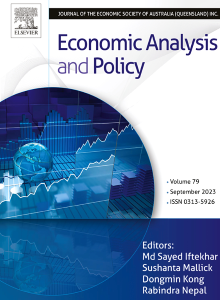Disentangling the effects of green finance in reducing CO2 emission from energy systems: Evidence from a novel factor decomposition mechanism
IF 7.9
2区 经济学
Q1 ECONOMICS
引用次数: 0
Abstract
Green finance is a potentially important factor for upgrading energy structures and thereby controlling CO2 emissions. However, previous research ignored it in the decomposition mechanism of CO2 emissions from energy systems. Accordingly, a novel decomposition model integrating green finance and energy is developed under the Generalized Divisia Index (GDI) framework. Furthermore, the integration of GDI, coupled scenarios, and Monte Carlo techniques facilitates the introduction of a novel approach for dynamically simulating prospective CO2 emission trajectories. The decomposition results imply that carbon factor and energy consumption stand out as the positive driving forces of CO2 emission, with relative contributions of 0.95 % and 8.29 %. The green finance scale exhibits insignificant impetus in mitigating CO2 emission, with a contribution of only -0.04 % in the last decade. However, the energy efficiency of green finance demonstrates substantial potential in all regions, contributing by -1.38 %. The forecasting results indicate that green finance will propel China's eastern region to achieve a steady decline in CO2 emissions by 2026 in the sustainability-driven scenario, whereas the central and western areas fail to achieve carbon peaking. Both top-level design and region-specific policies are required to curb energy-related CO2 emissions.
求助全文
约1分钟内获得全文
求助全文
来源期刊

Economic Analysis and Policy
ECONOMICS-
CiteScore
9.80
自引率
9.20%
发文量
231
审稿时长
93 days
期刊介绍:
Economic Analysis and Policy (established 1970) publishes articles from all branches of economics with a particular focus on research, theoretical and applied, which has strong policy relevance. The journal also publishes survey articles and empirical replications on key policy issues. Authors are expected to highlight the main insights in a non-technical introduction and in the conclusion.
 求助内容:
求助内容: 应助结果提醒方式:
应助结果提醒方式:


